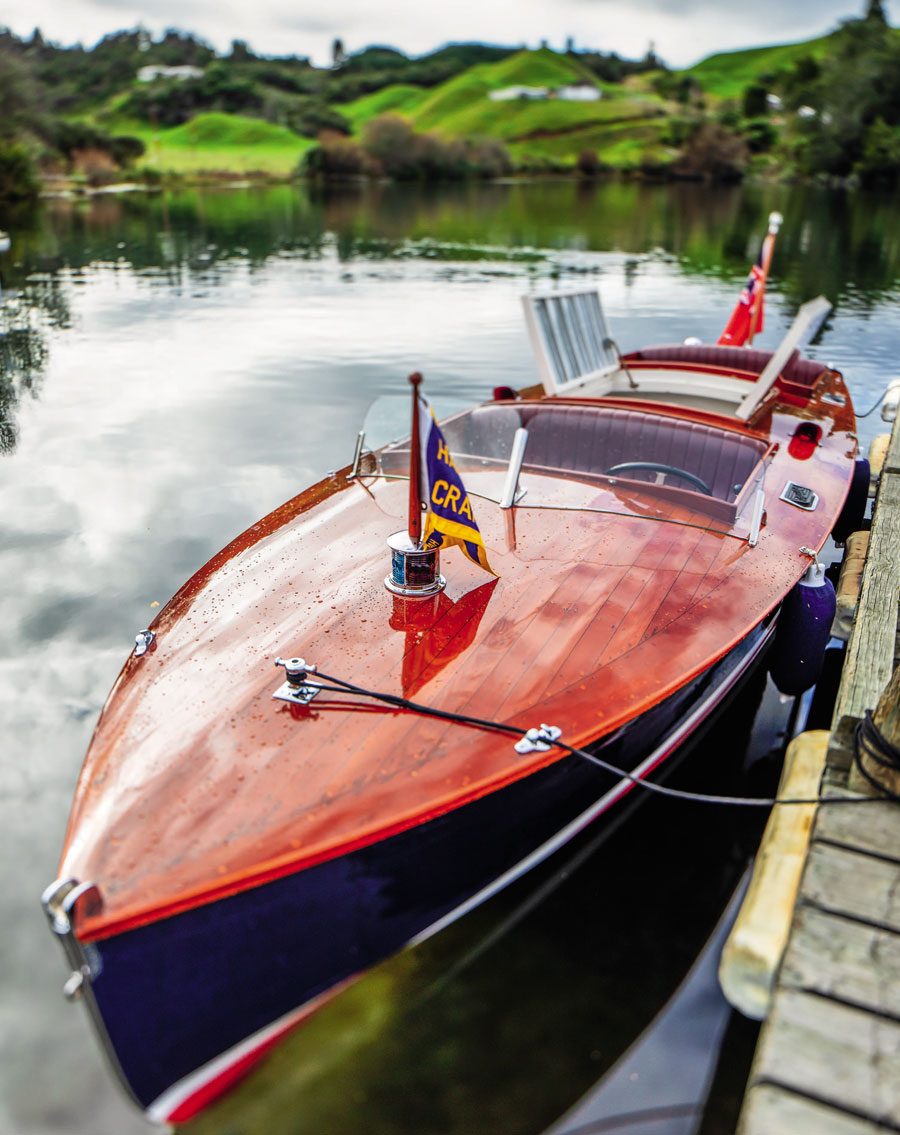

Words Alex Stone, Photos Lesley Stone.
Here’s a story of a boat and a bloke that couldn’t be kept apart. Even after two trial separations. Now, their third union looks like it’s forever. It’s going to be Happy Days – permanently – from here on, for owner Peter Davies.
It’s a story too, not of a boat alone, but of dedicated efforts by visionaries and craftsmen, to preserve a precious piece of New Zealand’s boating heritage. And, after a family’s 84-year on-and-off relationship with a lovely boat, it has a happy ending, too. What’s not to like? If all this sounds confusing, perhaps it’s best to go back to the beginning.
Happy Days is a venerable, vintage inboard-powered motorboat. Built in 1933 in Picton, she’s a John L. Hacker design, of the famous Hacker Craft company. These boats are American icons. The kind of gleaming, varnished, mahogany speedboats we associate with movies about the Roaring Twenties (before the Crash), and the days of rum-running during Prohibition.
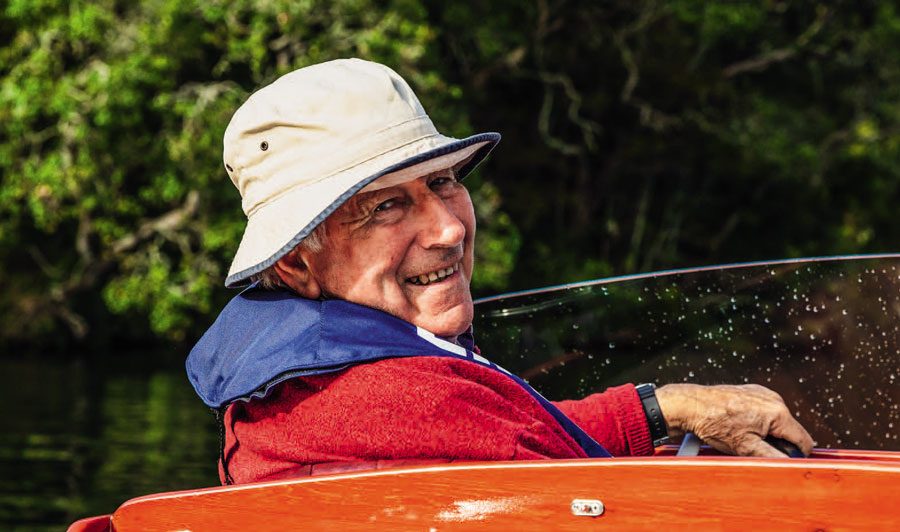
A fleet of them was used in the memorable 1975 movie Lucky Lady. They also featured in the Venice boat chase scene in Indiana Jones and the Last Crusade. Famous Hacker Craft have evocative names like Pardon Me, Thunderbird, El Lagarto, Bootlegger, Peerless, Dolphin, Kitty Hawk, Belle Isle Bear Cats, My Sweetie. And Kitty Hawk II, the fastest boat in the world in 1912.
Hacker Craft, the company, is based in upstate New York and has been in continuous production of mahogany powerboats since 1906 – with a diversion during WWll into Army Air Force rescue boats. The boats are listed as ‘among America’s top 50 products’. Up there, I imagine, with Harleys and Boeings.
They have simple lines that speak volumes. They are redolent of an age, not faded by faulty nostalgia, but illuminated by the allure of timeless craftsmanship, manifest in layers of glistening varnish. It’s all about dedication and love; repeated love, and enduring appeal.
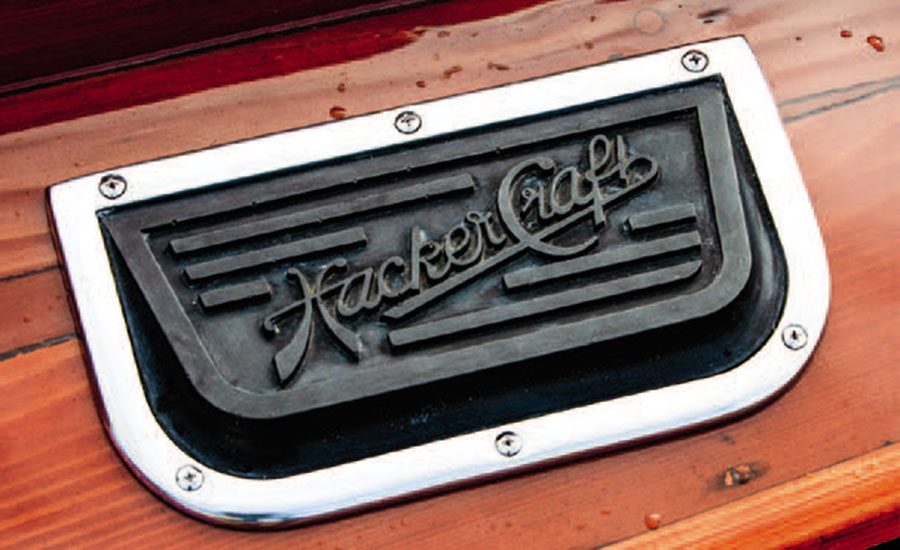
Her restoration took Alan Craig’s team 18 months.
Now, a Hacker is a collector’s item. They are still built at the original yard, after 115 years. A special feature of each boat is the famous Hacker logo on the mahogany topsides, in gold plate. I learn that “Designed by Hacker in 1916, the logo is applied by hand over a sized pattern with extremely thin 23-carat gold leaf sheets, tapped onto the boat’s mahogany planking then burled and outlined in paint. This process known as Gold Gilding, is still used on today’s Hacker Boats.”
There’s no such gold embellishment to Happy Days. It’s hardly needed. She’s special in other ways.
Happy Days was built by Swedish brothers Vic and Clarrie Olsen. Vic did the woodworking – Clarrie took care of all things mechanical. The Olsens built boats for the famous powerboat races for the Masport Cup, including the legendary Pelorus Jack.
This one is the 24-foot runabout design, with Hacker Craft’s trademark central engine separating a front cockpit from a rear ‘dicky seat’. Happy Days has a carvel-planked hull of kauri, with decks of western red cedar.

We’re trying to find a good spot on the lake for a quick G&T, but bloody Peter won’t slow down.
Initially powered by a marinised Austin 4 engine, she was built for a Blenheim dentist – a Dr Stocker. Davies’ dad Tom bought it from the good doctor, after the first of a few ultimatums that have defined Happy Days’ life. “It’s either me or the boat,” said the dentist’s practice, struggling in the Depression years. His wife said the same thing.
Tom acquired the boat and married (to Gint) in quick succession in 1938. They set off on their honeymoon in the aptly-named Happy Days, from Picton via the tricky French Pass to Nelson. Says Peter: “They sponged off farmers for petrol.” But those happy days – at least as far as the boat was concerned – couldn’t last. Gint said: “You can’t afford me and the boat.” Happy Days was sold in 1939.
But then along came the wool boom in 1951 – the high demand resulting from the US Army buying wool to equip troops for the unexpected cold in the Korean War. Wool peaked at the now-legendary ‘a-pound-a-pound.’
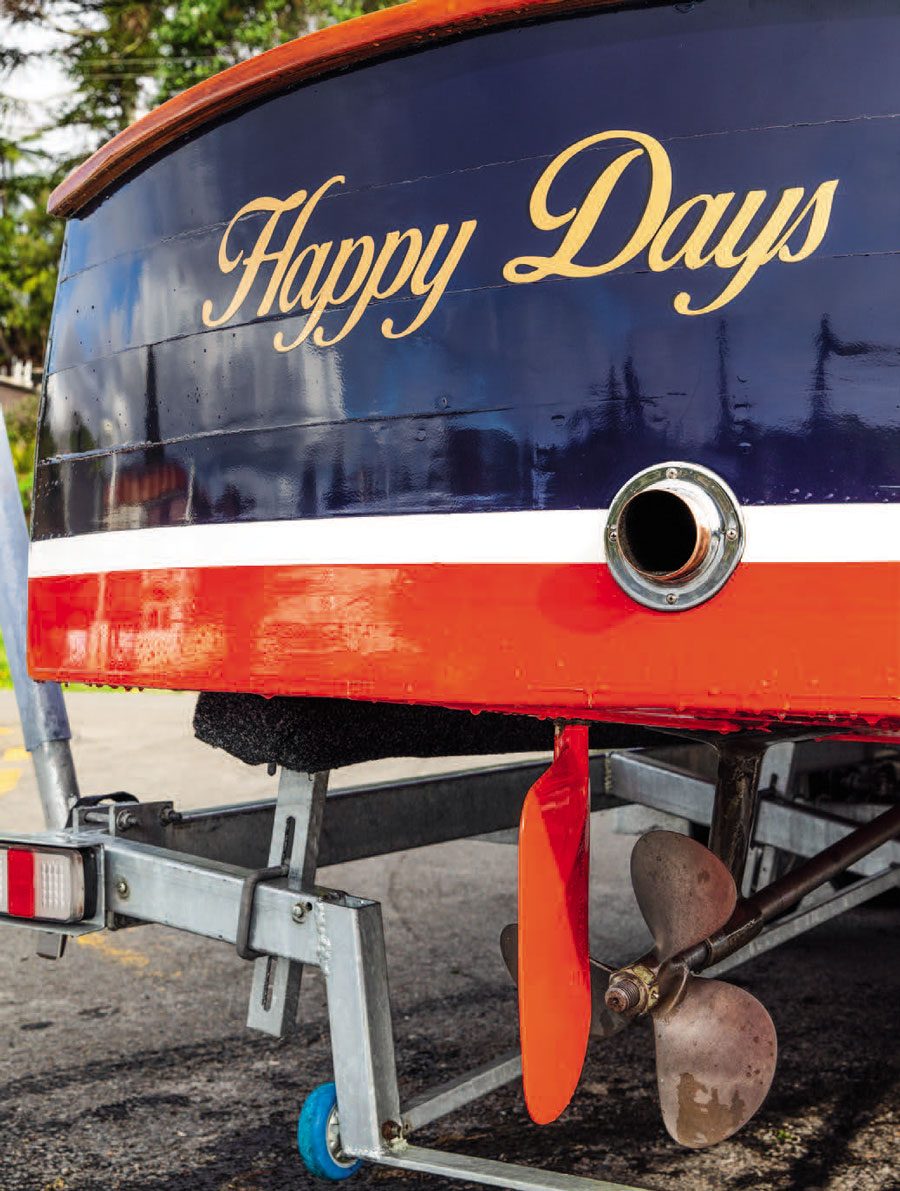
Years later Tom found the boat again in Picton and bought Happy Days back. He installed a Ford Osco Marine flat-head eight-cylinder engine. Used to power landing craft, some of these engines were left around by the Americans after WWll.
Peter took over the boat from his parents, but in 1966 his wife continued the theme. “We can’t afford to keep her.” And they were too busy pursuing their farming businesses. The boat was sold.
Ten years later an aunt rang Peter. She had found Happy Days languishing in a shed in Pelorus Sound. Peter bought her back in 1974 and stored her in a farm shed – now between Rotorua and the coast, where they run pedigree Herefords.
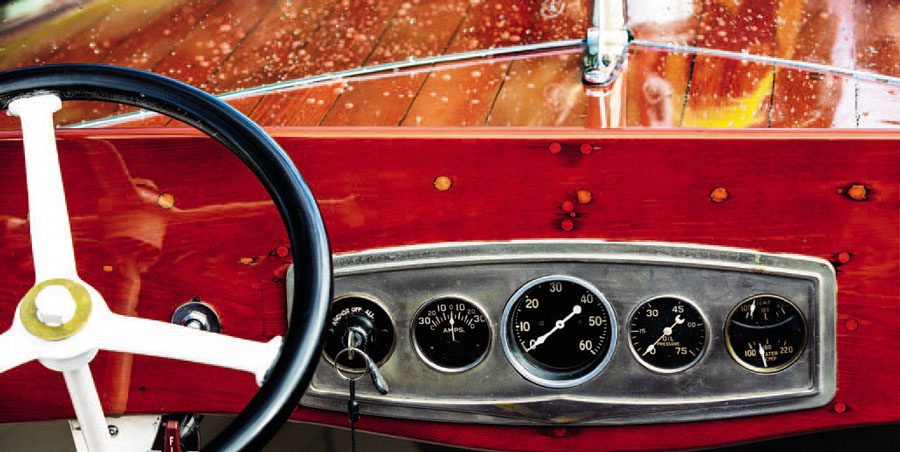
With the practical wisdom of a long-term, successful farmer, Peter notes “in good times put fat on your back, because it won’t last.” So a few years ago he resolved to restore Happy Days to her former glory. It was something he had to do, he says, “before I die.” By serendipitous coincidence, he found the extraordinarily talented boatbuilder and restorer Alan Craig living nearby. Alan was succinct and sure: “I can fix her.”
That initial, laconic response disguises what has been a remarkable and detailed transformation. Happy Days was shifted out of the farm shed, hoisted onto a truck and delivered to Alan. The restoration process went the Full Monty – the engine was entirely stripped, re-bored to 250 cubes and fitted with twin carbs.
It was a year’s work, in the total 18 months of the boat’s restoration. “All the internals were top-notch,” Alan says. “Basically, we ‘hot-rodded’ a whole engine.” The gleaming chromed parts underscore that point.
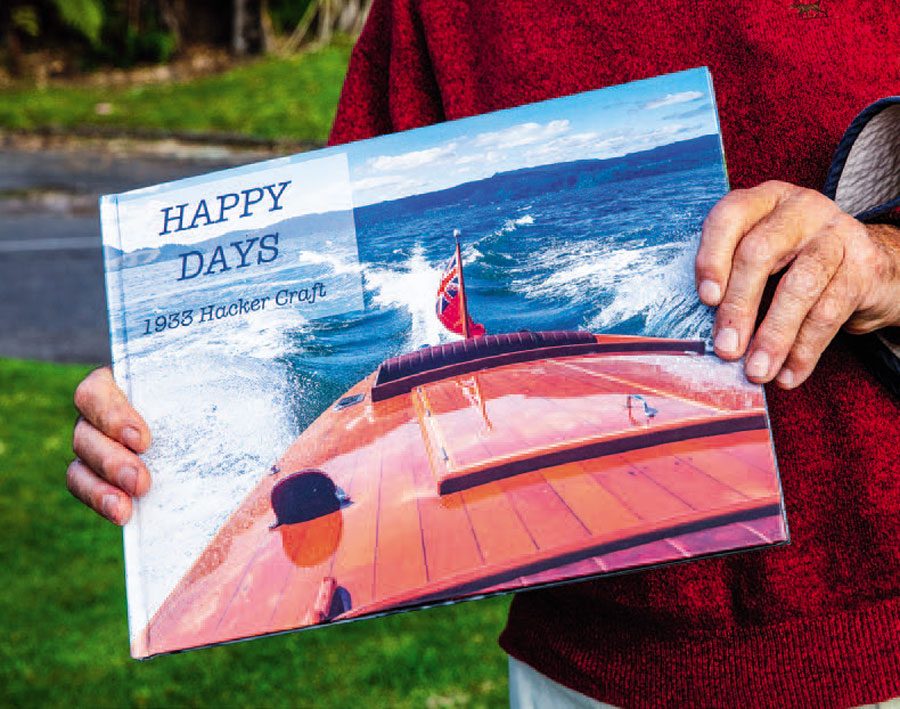
The photo album documenting the restoration – produced by Alan’s wife Fiona.
All this was unique in New Zealand. While there are plenty of American-designed Chris Crafts around of the same era, Happy Days is one of a more exclusive club. There are few other Hackers in the country.
Peter remembers his father allowing the kids to fish from the rear cockpit – this is now off the agenda. Rather, Happy Days is “really a cruising boat. We use it for lakeside picnics, and sundowners.” These naturally include, he says, “a little glass of gin.”
There’s a happy place where work and passion overlap. Only a few of us, it seems, are privileged to experience this. It’s often a fleeting moment in a life of work of the less-than- inspirational kind. Alan and colleagues Blair Du-Fall, Tony Hassel and Connor Gilbert are fortunate to have this for their entire working life.
They worked on Happy Days with a dedication that is immediately obvious when the long, lean boat rolls up to the Lake Rotoiti launching slip on her trailer. The decks gleam under “at least 12 coats of polyurethane varnish,” says Blair. “I know. But then, I think I stopped counting.”

They don’t build them like this any more.
Alan reflects on the project. “The brief from Peter was, ‘We’re gonna do it – and we’re gonna do it properly.’” Alan’s an experienced boatbuilder, having first done an apprenticeship through the Unitec boatbuilding school, then working at Martin Marine and, later, at Tauranga’s Southern Ocean Marine.
When that went “tits-up” he resolved to strike out on his own. His business has naturally evolved into restorations of classic lake boats – which is entirely fine by him. Restoration of Happy Days’ wooden parts was based on the maxim, says Alan, that he would “remember it’s an old boat.” So while wooden plugs were used to fill old bolt and screw holes, there are still some stains evident in the deck planking under the varnish.
They only serve to verify the boat’s age and the authenticity of the restoration. From Blair’s perspective – that of mainly working on the time-consuming deck restoration and re- varnishing, “we’re fortunate to have people like Peter.” For his part, Peter says, “I never considered the restoration myself.”
The engine was re-furbished by Rob Cowley of Hamilton’s ‘Rob’s Rods and Restos.’ It now sits in impeccable condition, with its many chromed parts, in Happy Days’ engine well. On our outing, Peter was careful to keep an eye on the temperature gauge.
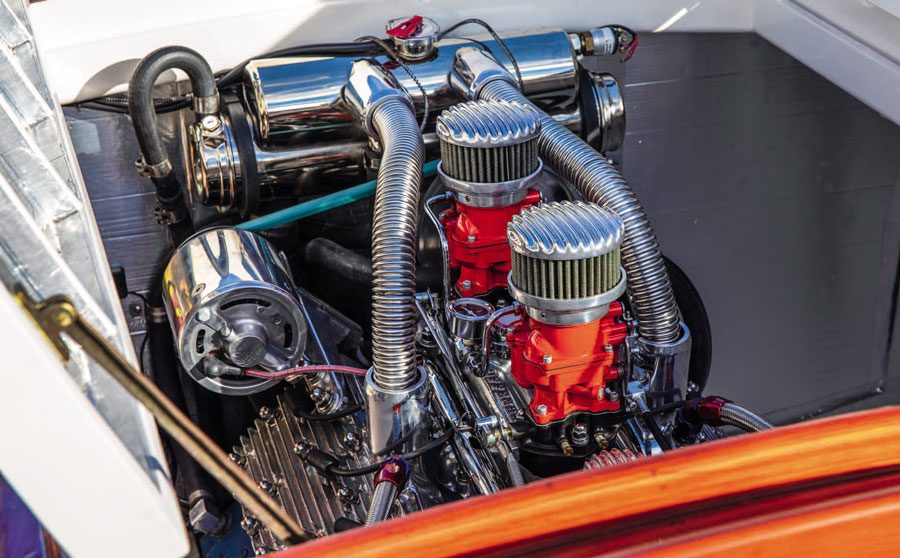
The flat-head V8 has been reinvigorated with a few modern add-ons.
The dashboard used to have red valve taps, mechanically linked to the engine. The refurbishment has removed the need for them. It’s clear that it’s still early days with regard to understanding the re-configured engine. But there’s appreciation all round. When I inadvertently mentioned ‘engine noise’, Peter immediately corrected me: “It’s not noise. It’s a wonderful sound – it’s music to me.”
He’s right, of course. It’s a burbling soundtrack that’s inextricably linked to Peter’s (and Alan’s and Blair’s) enjoyment of the boat. It shows in the delight obvious on Peter’s face when he’s throwing the boat around for the camera, tucked into the leather-upholstered steering seat, using the hand gear lever and foot throttle.
“I love old things. I love V8s.” And he adds, “it’s a Rolls Royce, this thing! It can turn on a sixpence. I’ll just chuck it around – hold on!” And I do, feeling his infectious joy, and hanging on to my hat.
We found Happy Days getting up on the plane at 2,000rpm. And despite appearances, the boat is way lighter on the trailer than the modern Buccaneer Sportsman 650 – Blair’s parents’ boat kindly loaned to us as a camera platform for the day.
The entire restoration process has been documented in a wonderful photo album, produced by Alan’s wife Fiona. It’s about as precious to Peter as the boat itself. Now Happy Days is all set for a glorious show at the annual Lake Rototiti Wooden Boat Parade during next year’s Waitangi Weekend.
Perhaps no amount of words can come close to the deep- seated joy that Happy Days brings – and will bring for years to come. Lesley’s photos tell the story best, methinks. Two old blokes, enjoying a boat of a similar vintage. And a restorer and his mate, brim-full of pride.
Happy Days is indeed a timeless classic. BNZ




